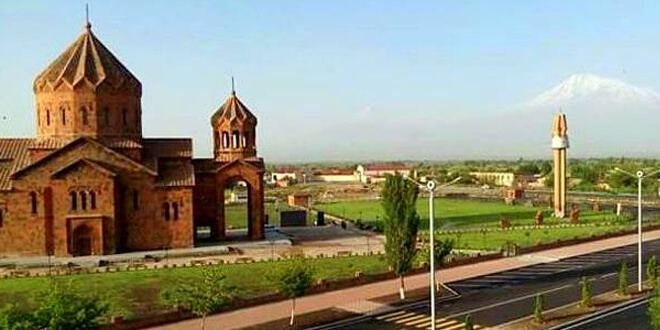Ararat Region


Area: 2,090 km2
Population: 260,367
Ararat is one of the regions of Armenia. The administrative center and the largest town of the province is Artashat. According to a prominent Armenian historian Movses Khorenatsi, Ayrarat was one of the 15 provinces of Armenia. It was the central province of the Armenian Highland.
The name of the region
The province was named after the biblical Mount Ararat. Anyone who visits Armenia will forever remember the most majestic and awesome scene in the world, the fabulous view of Holy Mount Ararat. It is the highest mountain (5165 m) in ancient Armenia with the highest peak Masis and the lowest peak Sis.
The mount gives a great opportunity for mountain climbers to conquer peaks of Ararat and enjoy the spectacular views from the heights of clouds. The best time for climbing the mountain starts in July and ends in September. Although Ararat is now in the territory of Turkey, it still remains the symbol of Armenia.
Ararat is a holy mountain not only for Armenians but also for the Christians of the world because Noah's ark landed on the mountain during the flood. Many scientists and researchers have tried to find the exact place of the ark. For this purpose, Ararat has even been photographed from satellites and many interesting facts, that indirectly confirm the existence of the ark, were discovered on the mount. So the mystery of Noah’s ark perhaps will be revealed one day.
One of the largest regions of Armenian Plateau has the same name - Ararat (Ararat plain). This region was famous throughout the Armenian history due to the paint called “Vordan Karmir”. The paint is obtained from the insect having the same name. In many Greek and Roman sources, the paint exported from Armenia was mentioned as the best red paint of that time. It was called «arqayakan tsirani» (Royal Red) and clothes of the noblemen were painted with “Vordan Karmir”. For decades, the existence of vordan karmir has been in danger because of pollution and other reasons, and for its protection, the reserve «Vordan karmir of Ararat» occupying 200 ha territory was formed in Ararat valley in 1987.
The Ararat Cognac
The culture of winemaking in Armenia goes back to ancient times, but the story of the famous Armenian brandy started at the end of the 19th century. It was in the land of Ararat, that the union of natural generosity and creative energy gave the best beverage that has become famous not only in this territory but also all over the world. Today the legendary ARARAT brandy is considered to be one of the symbols of Armenia.
Sights of Ararat Region
Ararat Province is famous for Khosrov Forest State Reserve, covering some parts of the Geghama Ridge. The history of the reserve goes back to 330-338 A.D. when the Armenian king Khosrov the Third ordered the forest to be a reserve to improve the natural-climatic conditions of the neighboring city of Artashat and to ensure conservation and enrichment of flora and fauna. Here the historical capitals of Armenia: Artashat and Dvin were situated.
Among the other sights of interest of the region are the monastery of Khor Virap (XVII century), the monastery Aghjuts (XIII century), Havuts Tar (X-XVIII centuries), Shenats Vanq (VI — XV cent.), the Kakavaberd fortress (IV - XII centuries), and also the ruins of ancient capital Dvin.
Population and ethnic groups of Ararat
According to the official census, the population of Ararat consists of 260,367 people. Besides Armenians, Yazidis also live there.
Artashat

Artashat is located in the Ararat plain, on the bank of the Araks River. It is the administrative centre of the Ararat region which is 30 km southeast of Yerevan. Artashat was founded in 1945 in Soviet Armenia and was named after the ancient city of Artashat which was located not far from the present-day town.
History of Artashat
This city is one of the oldest cities in Armenia. For about four decades the city was the capital of Armenia. The Armenian King Artashes 1st founded the city in 176 BC. It was known as "Vostan Hayots"(Armenian royal residence) or "court city".
The ruins of the ancient city are not far from the present-day Artashat. The most famous monument in modern Artashat is the statue of the Armenian King Artashes 1st.
King Artashes had also built a citadel which was later named Khor Virap. Gregory the Illuminator was imprisoned here for 14 years by King Trdat 3rd. In Khor Virap, you will see the big hole where Saint Gregory was imprisoned.
Khor Virap Monastery is a great example of Armenian architecture. A great view of Ararat valley, and of Biblical mountain Ararat opens from the church.
Places of Interest in Artashat
One of the most popular places in the city is Artashat’s Lake. The locals love this place and will likely invite you there for a walk.
The church of St. Hovhannes built in 2015, is the most beautiful structure of Artashat. The city had no church before. There has been a small chapel which is the residents’ favourite place.
The cultural life of Artashat is improving due to the activity of several institutions. There is a palace of culture in the town, an art centre named after Charles Aznavour, a drama theatre after Amo Kharazyan (which regularly performs Armenian and international classic and modern works), and a public library named after Ohan Chubaryan opened in 1948.
In 2004, a new entertainment park was opened in the centre of Artashat that hosts public celebrations, concerts and musical shows. Thus in Artashat, you will surely find how to spend your time.
City/town
Sights
Khor-Virap
Khor Virap monastery is located in Ararat region near Lusarat town. This monastery is considered to be Armenian famous sanctuary and pilgrimage.
Read More



